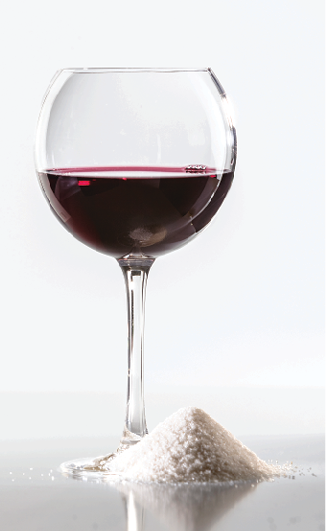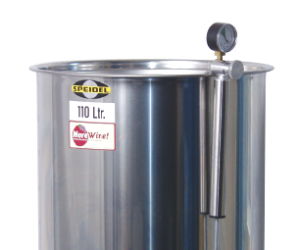 In ancient Greece and Rome, honey was sometimes stirred into wine just before serving. Maybe they just liked the taste of honey. More likely, though, the sweetness of the honey corrected some fault of bitterness or sourness. It might have enhanced fruitiness or rounded out mouthfeel. Honey, sugar, or other sweeteners can still make those improvements in your homemade wine today. Since we would rather have a shelf-stable, ready-to-drink beverage instead of mixing up wine cocktails, techniques have been developed over the years to sweeten wine in a stable manner.
In ancient Greece and Rome, honey was sometimes stirred into wine just before serving. Maybe they just liked the taste of honey. More likely, though, the sweetness of the honey corrected some fault of bitterness or sourness. It might have enhanced fruitiness or rounded out mouthfeel. Honey, sugar, or other sweeteners can still make those improvements in your homemade wine today. Since we would rather have a shelf-stable, ready-to-drink beverage instead of mixing up wine cocktails, techniques have been developed over the years to sweeten wine in a stable manner.
Most modern wine ferments dry (or nearly so). Various authors put acceptable sugar levels in “dry” wine somewhere between 2 and 4 grams per liter (0.2% to 0.4%). Much above those levels and you get into sweet wine territory. Even beyond stirring in some honey, there are four ways wine is purposefully made sweet. The first method involves picking or processing (drying, freezing, rotting) grapes to very high sugar levels resulting in a natural stop in fermentation as the alcohol level climbs; a deliberate “stuck” fermentation. French Sauternes is made in this technique. The second method is to partially ferment a must, also frequently with high starting sugar levels, and then add grape spirits (neutral brandy) to stop the fermentation. That is the traditional Port technique from Portugal. The third method starts with grape sugars in a normal range for dry wine, but fermentation is stopped before completion to dryness, often by chilling, sulfiting, and filtering. Sweet Gewürztraminer and Riesling wines are sometimes produced in this manner. Finally, a wine can be fermented all the way to dry, then sweetened and stabilized before bottling. That method is called back-sweetening and is the subject of today’s “Techniques” column. Adding sugar to wine is sometimes referred to as “chaptalization,” but that term is more often given to adding sugar to must with the intent of raising the final alcohol level.
To consider sweetening your wine, it helps to review some aspects of sweetness itself. The principal sugars in grape must are glucose and fructose. Each of these is a six-carbon sugar that can occur in either a linear form or a cyclic ring. As individual sugars, they are referred to as monosaccharides. When a molecule of glucose combines with a molecule of fructose, the resulting disaccharide is sucrose: Table sugar. There is some sucrose in grapes — it makes up about three percent of the total sugars, with glucose and fructose each accounting for about 48% (the small remainder includes five-carbon sugars like arabinose and xylose). This matters because when we talk about sweetening, not all sugars are perceived as equally sweet on the human tongue.
One good way to compare sweetness is to prepare solutions of sugars that a tasting panel judges to be equally sweet. In Concepts in Wine Chemistry, Yair Margalit presents a table of such “iso-sweet” comparisons. Using a 10% sucrose solution as reference, it requires only an 8% solution of fructose to achieve the same perception of sweetness. By contrast, it requires 18% glucose for the same effect. This all matters in winemaking because it affects the outcome of sweetening. Wine yeast, Saccharomyces, consumes glucose at a faster rate than fructose. In a normal fermentation, that means any residual sugar left when fermentation stops will be more heavily weighted toward fructose, since the glucose is consumed sooner. Since fructose tastes sweeter, a given numerical value of residual sugar from fermentation will taste sweeter than the same concentration of sugar that comes from back sweetening with sucrose.
While commercial winemakers make sweetness decisions based on market acceptance, as a home winemaker you can please yourself. Most red wines (other than Ports) are fermented and bottled dry (or very nearly so). When it comes to making wines that might be described as off-dry or medium sweet, white wines and rosés are much more common than reds. Fruit wines and their blends are also commonly bottled sweet because sugar enhances the “fruitiness” in these beverages.
Sweetening is useful for balancing acidity. Wines with different acidity require different amounts of sugar to give the same level of perceived sweetness. Trials are essential for such situations. If you decide you want a sweet or off-dry wine, or you need to balance acidity with sugar, you need to make several decisions before you get to the math of calculating your final product. As noted above, a stopped wine provides a higher perception of sweetness at a given sugar concentration than does the same level of added sugar. Stopping wine at home and stabilizing it, however, is difficult. You would need to chill the wine to slow or stop the yeast, rack it off the bulk of the yeast lees, sulfite at a high level, and sterile filter or add potassium sorbate (or both) to prevent refermentation. Adding a sweetener after fermenting dry — back sweetening — is a lot easier.
Sweeteners also offer choices. Sucrose is readily available in the form of cane sugar or beet sugar. White sugar is highly refined, very soluble, and quite pure. It tastes very sweet. Fructose tastes sweeter, but is not readily accessible for use at home. Glucose, in the form of dextrose or corn sugar, is sold at home winemaking shops. While very useful in chaptalization because of its ready fermentability, its lower sweetness makes it less desirable for back sweetening. Honey, mentioned above, and brown sugar offer additional flavor characteristics, but both of them may make the wine more difficult to completely clarify. Non-fermentable sweeteners such as xylitol or stevia may be employed without risk of refermentation, but many people perceive off-flavors when they are applied to wine.
Sweetening with a natural grape product offers another route. Some sweet German wines are made by separating a portion of the original must, highly sulfiting it, and then blending it back in after the main batch has fermented to dryness. This “sweet reserve” technique could be applied at home by freezing some juice at harvest and then mixing it back in after fermentation. Sorbate can be applied to a home “reserve” sweetened wine to prevent refermentation. Sweetening with grape concentrate can also be effective and is included in the calculations that follow. Keep in mind, though, that not just the sugar is concentrated when water is evaporated from grape juice. Most of the original acids are still in there as well; an addition of concentrate may change your wine in unexpected ways. Taken together, these factors lead to sucrose, most often cane sugar, as the home winemaker’s most likely choice for back sweetening a finished wine.
To plan your sweetening, you will want to run some trials. One good way to do this is to thief out a 375-mL sample of your wine. Measure it out into three separate 100-mL samples for treatment and keep the remaining 75 mL as a control. You can do any level you like, but common “off dry” sweetness is about one to three percent, so this model lends itself to trying 1%, 2%, and 3%. To do your trials with sucrose, prepare a standard solution that is 50% weight/volume cane sugar. °Brix is percent sugar on a weight/weight basis, but it is so much easier to measure small volumes at home (instead of small weights), so we are preparing the standard solution on a weight/volume basis instead. That way, we can measure small amounts of solution by volume instead of trying to weigh them out.
Larger amounts are easy to weigh with a small digital scale. Weigh out 50 g (about 2 ounces) of sugar and place it in a small saucepan. Add 50 mL (also about 2 ounces) of distilled water and bring to a boil. Stir to dissolve. After boiling briefly, cover the pot and place it in an inch or two of cold water in the kitchen sink to cool. When the sugar syrup is completely cool, transfer it to a 100 mL volumetric flask, graduated cylinder, or graduated beaker. Dilute to exactly 100 mL with distilled water. Now you have a sugar solution that contains 50 g of sugar in 100 mL of solution, or 0.5 g in every milliliter.
You may also want to try sweetening with grape concentrate. You can do this instead of a sugar trial, or alongside a sugar trial to judge both sweetness and flavor effects. Most canned concentrate is specified at about 68 °Brix. At that concentration, one producer reports that it contains about 840 grams of sugar in every liter of concentrate. To keep the math consistent, we want to prepare a standard solution of the concentrate for trials that matches our sugar solution: 0.5 g in every mL. To do so, we want to deliver 50 g of sugar equivalent (just as with our sucrose standard) into the 100-mL volumetric flask, graduated cylinder, or graduated beaker.
To figure out how many milliliters to use, X, we can use the ratio:
(X mL/50 g) = (1,000 mL/840 g)
Which rearranges to:
X mL = 50 x (1,000/840)
And solves to:
X mL = 59.2
Using a graduated cylinder, measure out 59 mL of concentrate, pour it into the volumetric flask, and dilute to exactly 100 mL with distilled water. Mix well and you have a solution of grape concentrate for trials that matches the sugar standard solution of 0.5 g of sugar per mL or 50% weight/volume. (If your grape concentrate is other than 68° Brix, check with the supplier for the appropriate sugar content value.)
Now we can proceed to trials. Since both standard solutions contain 0.5 g of sugar in every mL, two mL contains one gram. For a one percent sweetening of a 100-mL wine sample we will add 2 mL of standard solution. For a 2% trial, add 4 mL to a 100-mL wine sample, and for a 3% trial add 6 mL. If you wish to try other sugar concentrations, just add 2 mL of standard solution for every 1% increase in a 100-mL wine sample.
With 1%, 2%, and 3% samples prepared, do your tasting along with your untreated control sample. Have another person or two taste with you to facilitate discussion of the effects. Is the wine better sweetened? If so, what is the best level? If you are doing such a comparison, does sugar or grape concentrate taste better?
Once you reach a conclusion, do the calculations to sweeten your whole batch. At this point, there is no need to prepare the sugar as a precise standard solution. Instead, we want to add as little water as feasible with the sugar to minimize dilution of the wine. For the concentrate, that means adding it directly as it comes from the can. For cane sugar, make a “simple syrup.” For your calculations of either sweetener, it is easiest to work in grams, since you have done your trials on that basis.
You will be using the relationship:
1% w/v = 1 g/100 mL = 10 g/L
For every liter of wine you want to sweeten, you need to introduce 10 g of sugar for every percent increase. The formula may be represented as:
Percent sweetening desired x liters of wine x 10 = total grams of sugar to add
For example, suppose you have 5 gallons of wine to sweeten, and you have decided you like the 3% sweetening level:
5 gallons x 3.785 liters/gallon = 18.9 liters
3% x 18.9 L x 10 = 567 grams of sugar
To use cane sugar, weigh out your total sugar amount (in our example, 567 g) and put it in a saucepan with 1⁄2 to 1 times as much distilled water. Stir to mix, then simmer over low heat for about 3 minutes (do not scorch!). Allow to cool, and proceed with the wine addition. For concentrate, you need to use the calculation we just did to determine how much sugar is needed, then use the ratio described above (or the right factor for your particular concentrate) to determine the volume of concentrate to add.
The generalized ratio (solving for X) is:
(X mL/grams of sugar needed) = (1,000/840) (or the correct weight/volume sugar content factor for your concentrate)
For our example:
(X mL/567 g) = (1,000/840)
X mL = (1,000/840) x 567
X mL = 675 mL of concentrate in 5 gallons of wine
Now that you have your calculations done, you can proceed to the treatment of the batch. I like to do sweetening in the bottling bucket. I rack the wine into the bucket, stir in the simple syrup (or concentrate) with a sanitized stainless steel spoon, stir in potassium sorbate to prevent refermentation (about 1 gram per gallon), and make a final sulfite addition based on my most recent free SO2 test results. I find it convenient to do the sweetening just before bottling because it combines the last racking with bottling and it eliminates the problem with any headspace I may have created by thiefing out my trial sample. There are authorities, though, who recommend sweetening and stabilizing the wine with sorbate in bulk a few weeks prior to bottling. When sweetening with concentrate, the time should not make much difference because the sugar is already present as a mixture of glucose and fructose. With sucrose, though, changes will occur. The natural conditions in the wine, over perhaps days or weeks, will “invert” the sucrose to glucose and fructose.
As noted earlier, glucose is not as sweet as sucrose, but fructose is sweeter. If we assume Margalit’s ratios will hold in a mixture, we can see that the equivalent might be that 10% sucrose inverts to a flavor of 10% x [(10%/18% sweetness equivalent glucose) + (10%/8% sweetness equivalent fructose)]/2 = 9.0% sweetness equivalent. In theory, you might want to increase your sucrose addition by 10% to account for the drop in apparent sweetness when it later inverts in the wine. Or, you might want to do your addition a few weeks early, hold the wine in bulk, and taste again before bottling, possibly with a small final addition.
Another advanced alternative is to invert your own sugar for the tasting trials. In Modern Winemaking, Philip Jackisch provides a recipe to invert a glucose + fructose solution from sucrose that is equivalent to the sucrose trial solution given above. He recommends dissolving 47.5 grams of sucrose and one gram of citric acid in enough water to make 100 mL and heating to near boiling for half an hour. Cool and dilute to exactly 100 mL as above. That solution will now contain exactly 0.5 g of (glucose + fructose) per milliliter, but it will also contain a bit of citric acid, which may affect the flavor in your trials. You would only use this invert syrup for the trials. For the addition to the wine itself, you would not want to add citric acid, which could affect the wine’s microbial stability. Just add sucrose and it will invert naturally over time.
With all the variables of sweetening trials, I consider 90% close enough (9% apparent sweetness on a 10% sucrose addition). The “iso-sweet” levels are averages from human taste panels and are not absolute. Since your perception may vary, I suggest going with the basic calculation, trial and sweeten with sucrose, taste the wine over a period of time, and adjust your planning for future batches if needed. And keep your notes—you may want to review your wine math again next time!







